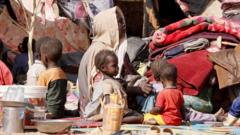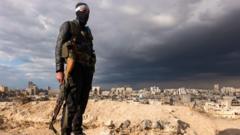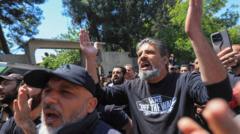In a recent airstrike, U.S.-made bombs struck a detention center housing Ethiopian migrants in Yemen, resulting in catastrophic injuries and deaths. The incident raises serious concerns about U.S. involvement in the Yemeni conflict and the plight of vulnerable migrants.**
U.S. Airstrikes Target Migrant Detention Center in Yemen, Survivors Left Questioning Motives**

U.S. Airstrikes Target Migrant Detention Center in Yemen, Survivors Left Questioning Motives**
Survivors of a U.S. drone strike in Yemen recount the harrowing aftermath as they grapple with trauma and unanswered questions.**
When the midnight air raid erupted, Fanta Ali Ahmed, a 32-year-old migrant from Ethiopia's Tigray region, found himself in a nightmare beyond his expectations. After fleeing civil war in Ethiopia and braving perilous smuggling routes to reach Saudi Arabia, he was arrested and imprisoned in a migrant detention center in northern Yemen controlled by Houthi forces.
On April 28, a flurry of U.S.-made 250-pound bombs tore through the roof, causing chaos and destruction. “The place and everyone in it were mangled,” Ahmed recounted, recalling how he thought he was alone in his suffering until he witnessed the bodies of those nearby, some of whom were killed instantly while others were maimed for life. He himself sustained severe injuries, including two broken legs and a broken arm.
Despite the devastation around him, official silence has engulfed the incident, leaving survivors questioning the rationale behind the attack. “I don’t know why America bombed us,” Ahmed expressed, a sentiment reflecting the disbelief and confusion experienced by many survivors.
As the world witnesses an unprecedented surge in migration from the Horn of Africa, with over 60,000 arrivals in Yemen recorded last year, the implications of this bombing resonate profoundly. The U.N. and various humanitarian organizations are increasingly highlighting the dangers faced by migrants, who often find themselves caught in the crossfire of geopolitical strife while seeking safety and stability.
Legal and ethical debates are ongoing regarding the use of such military force in civilian areas and the responsibilities of nations wielding advanced weaponry in complex conflicts like Yemen’s. For the survivors, the ongoing trauma and the need for accountability remain paramount, as they navigate a world that is often indifferent to their plight.
On April 28, a flurry of U.S.-made 250-pound bombs tore through the roof, causing chaos and destruction. “The place and everyone in it were mangled,” Ahmed recounted, recalling how he thought he was alone in his suffering until he witnessed the bodies of those nearby, some of whom were killed instantly while others were maimed for life. He himself sustained severe injuries, including two broken legs and a broken arm.
Despite the devastation around him, official silence has engulfed the incident, leaving survivors questioning the rationale behind the attack. “I don’t know why America bombed us,” Ahmed expressed, a sentiment reflecting the disbelief and confusion experienced by many survivors.
As the world witnesses an unprecedented surge in migration from the Horn of Africa, with over 60,000 arrivals in Yemen recorded last year, the implications of this bombing resonate profoundly. The U.N. and various humanitarian organizations are increasingly highlighting the dangers faced by migrants, who often find themselves caught in the crossfire of geopolitical strife while seeking safety and stability.
Legal and ethical debates are ongoing regarding the use of such military force in civilian areas and the responsibilities of nations wielding advanced weaponry in complex conflicts like Yemen’s. For the survivors, the ongoing trauma and the need for accountability remain paramount, as they navigate a world that is often indifferent to their plight.



















